International Gas Detectors (IGD) recently completed a large gas detection system project in partnership with Medical Pipelines Services Ltd. The Manchester Engineering Campus Development, for the University of Manchester, is the UK’s largest engineering campus with over three hundred (300+) IGD TOC-750 addressable gas detectors protecting staff and students 24/7.
This turnkey project was completed with one of IGD’s Aftercare partners Medical Pipeline Services Ltd. The resulting installation has over three hundred TOC 750 safe area detectors, ten TOCSIN 750 control panels connected to a centralised HMI panel, all covered by IGD’s 10-year guarantee. Their case study will delve into what the MECD facility is, who Medical Pipeline Services Ltd are and how their industry first, 2-Wire Addressable gas detection systems are safeguarding staff and students at Manchester University.
Manchester University and MECD Overview
The Manchester Engineering Campus Development (MECD) is the largest engineering campus in the UK covering 80,000 sqm of research and educational space. It will house a community of 8,000 students, researchers, and academics. The MECD building compromises of Engineering Building A and B, the James Chadwick Building (Upper Brook Street), Oddfellows Hall and York Street Building.
MECD is part of a world-class research and innovation hub and immediately adjacent to two flagship centres of excellence – the National Graphene Institute and the Henry Royce Institute, the UK’s national institute for advanced materials research and innovation (both institutes have IGD gas detection systems already installed). The University of Manchester is ranked as the world number one in the THE Impact Rankings and this investment will ensure that Manchester continues to be at the forefront of delivering world-class research.

The MECD building uses a variety of inert and toxic gases across all buildings. These include nitrogen, oxygen, argon, carbon dioxide, carbon monoxide and fluorine. The site therefore required a gas detection system that can continuously monitor for these hazards as required by UK legislation. Additionally, the system needed to have the flexibility to add or change gas types easily as the site evolves.
Gas Detection System Scope of Work – MECD
The requirement at MECD was initially to provide connected gas detection systems across 10 floors and three buildings.
Due to the size of the gas detection system required, the project went out to tender to multiple gas detection companies.
Unlike IGD, many of the companies tendering offered dated analogue technologies or PLC based systems. These types of systems present several issues.
PLC (or Programmable Logic Controller) based systems are a long-established approach in a process control environment. They can provide reasonable connectivity but also need bespoke programming. This is usually their downfall in gas detection terms. Gas detection systems are life safety systems and therefore, require rigorous third-party approval to recognised standards in much the same way as fire and smoke detection systems. Bespoke programmed PLC systems assembled from standard parts have usually not undergone that rigour and so cannot provide the level of security required to prove compliance to safety standards. This type of system usually uses analogue detectors in field. In common with companies offering approved systems but using analogue detectors these also have major drawbacks.
Shortcomings of Analogue Gas Detectors
In common use for many years, analogue systems are now generally superseded by digital technologies. Analogue detectors require their own individual interface cable back to the controller making them uneconomic to install. The detector head output signal must be calibrated and so too must the PLC or controller input. This introduces errors when viewing readings on controllers and detectors and drastically increases the cost of ownership. Analogue signals are also prone to EMC interference from other local installations. This is problematic in a small environment such as a lab, never mind a large multi gas detection system. Functionality is also limited requiring a lot of intervention to add or change detector types, further adding to the ongoing cost of ownership. Such systems tend to rely on conventional alarm signalling which can be confusing in a complicated engineering environment with many safety systems. Analogue (4-20mA) systems are also inflexible in their design. This means they are hard to adapt to change, especially on sites/labs where gas hazards can change frequently which requires changing of gas detector heads to match the gas hazard.
IGD’s Gas Detection Solution
IGD’s solution for MECD and many other clients is our addressable gas detection systems. Our systems are approved to international third-party approvals and are extensively tested and developed in our specialised facilities. This provides peace of mind for the client, that required safety standards have been met or exceeded. The IGD systems offered are fully digitally addressable, allowing detectors to be efficiently networked to controllers. IGD’s Sentinel+ technology platform allows multiple detectors on a single 2-Core cable run up to 1000M. The detectors are powered and communicate over a 2-Core cable which has no polarity requirement when installing. This reduces connection errors and dramatically reduces installation time. In addition, each detector has its own I/O ports allowing interfacing to a variety of devices without the need for extra hardware and consequent installation costs. For MECD this meant a vast simplification when interfacing to break glass units, gas control valves and illuminated signage etc.

Additionally, room entries are protected using IGD’s Room Status Indicators. These provide a clear unambiguous indication in an otherwise complex environment. Room Status Indicators are installed and powered on the same cable run as the detectors.
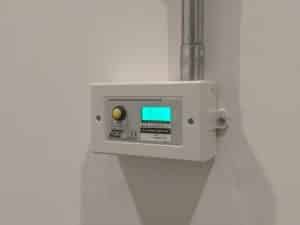
Controllers can “FIND” and install connected devices automatically, with each device reporting exactly what it is and its status to the controller. In this manner controllers automatically install detectors and room status indicators autonomously. This removes commissioning errors when setting up systems leaving the engineer free to concentrate on the cause-and-effect alarm setup. Controllers are also securely WiFi enabled allowing offline programming and backup of each system. Clients can also connect from any WiFi enabled device to download event logs and system reports without the need for internet connectivity. This allows full traceability for both clients and service engineers. The system controllers (10 in total) all interface back to a centralised HMI panel. Controllers can have their own GSM connection for full IoT (Internet of Things) connectivity.
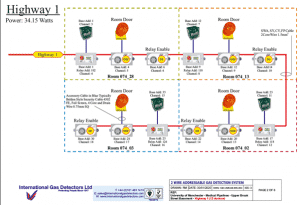
The staff at MECD chose to digitally interface to a command HMI. This provides a full overview of the whole connected system with full data logging and trending facilities. In addition, the HMI has connectivity to the site BMS system to provide alarm status.
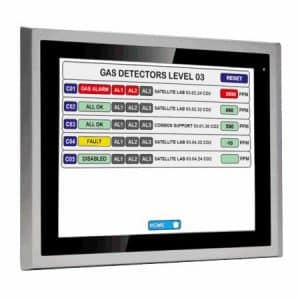
The TOC-750 addressable gas detectors were provided pre-calibrated further speeding installation and allowing for fast sensor swap out or replacement. This later point is important as the systems can recognise when a gas detector has been “hot swapped”, communicate and update to the new sensor. These hot swappable sensors provide fast replacements for when detectors/sensors near the end of their operational lifetime. An added benefit of our “hot Swappable” is the ability to change gas types easily. This is ideal for laboratories with changing requirements and gas hazards. For example, on a conventional system, changing from a CO sensor to a CO2 sensor would require a specialised engineer and additional site work to alter the controller setup. On an IGD addressable gas detection system, you just change the sensor, and the controller will detect the change.
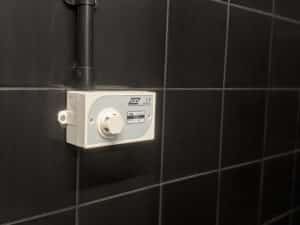
The TOC-750 series gas detector in question will update to the new gas type, new range, and update alarm levels automatically. The detector will stay in its configured alarm group so all that is required is to plug in the new detector head. This provides ultimate flexibility in a changing safety environment. Of course, the other benefit with digital technologies is that it is the same digital reading whether you’re looking at it on a detector, at a room status indicator, on the controller, HMI, BMS or over the internet. There are none of the errors associated with analogue systems.
IGD’s Long Life Sensor Technology and 10 Year Warranty
The university also benefits from IGD’s leading long life sensor technology ensuring their oxygen depletion, CO2, N2O and CO detectors have a 5 year+ lifetime. They also benefit from their leading 10-year no quibble warranty on the electronics manufactured by IGD; ensuring the university benefitted from the most advanced gas detection technology with low maintenance cost. In comparison the industry standard for oxygen and CO lifetimes are less than 3 years. Our TOC-750S N2O detector is the only stable and commercially available N2O detector on the market.
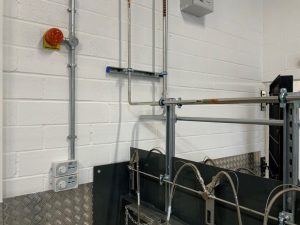
IGD Aftercare and Medical Pipeline Services
After successfully installing over 300 gas detectors at MECD, IGD have now offered the university staff free training on how to incorporate the gas detection system (s) into their site safe operating procedure (SOP).
IGD have successfully trained Medical Pipeline Services, on their certified gas detection service engineer’s course. This provides several benefits to Medical Pipelines and the university. Firstly, Medical Pipeline Services are now part of the brand new IGD Aftercare programme. They can demonstrate to the university that their engineers are fully trained and competent to maintain the IGD gas detection systems installed onsite. Medical Pipeline Services, being part of IGD Aftercare and their training programme, can ensure the gas detection systems at MECD are maintained correctly and continue their 10-year warranty.
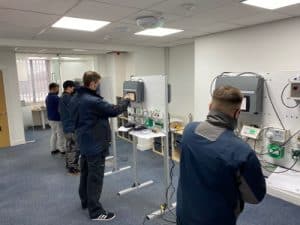
Alex Tighe from Medical Pipeline Services comments on this project and his thoughts about both working with IGD, their equipment and being part of the IGD Aftercare+ brand:
“The IGD 2-wire system with the TOC 750 panel was the perfect fit for the MECD project, offering the flexibility, potential for future expansion and the connectivity required to deliver a future proof installation. IGD have supported our project team all the way from product manufacturing through to technical support, becoming an IGD Aftercare partner has been an easy choice to make.”
Adam Pilkington, IGD’s UK Sales Manager further commented
“This was a fantastic project to work on. It started just over 2 years ago with IGD assisting in the design of the system in conjunction with Medical Pipeline Services and the University. This project not only demonstrates the capability of both IGD and Medical Pipeline Services, offering design, installation, service and training. But it also demonstrates the immense flexibility IGD’s ground-breaking 2-Wire Addressable gas detection systems have compared to what is currently available on the market. It also further demonstrates customer requirements for digital and IoT enabled gas detectors which is exactly what the TOC-750 systems provide. I am immensely proud of both Medical Pipeline Services and the IGD team for implementing and completing this project. It truly is both a monumental and historic project for the gas detection industry.”
The Outcome
The gas detection system installed at MECD is one of many large UK gas detection projects IGD has undertaken using IGD’s, 2-Wire Addressable gas detection systems. The MECD building now has over 300 digital addressable TOC-750 gas detectors, with enhanced long-life sensors. The university now have a modern, IoT enabled, addressable gas detection system which is future proofed thanks to our leading 10-year warranty and long-life sensors. In addition, we are delighted to work with Medical Pipeline Services and have them as part of our credited IGD Aftercare brand. This project further demonstrates the industries move to true addressable technology and IoT enabled gas detection systems, of which IGD are the leading innovators and manufacturers.





